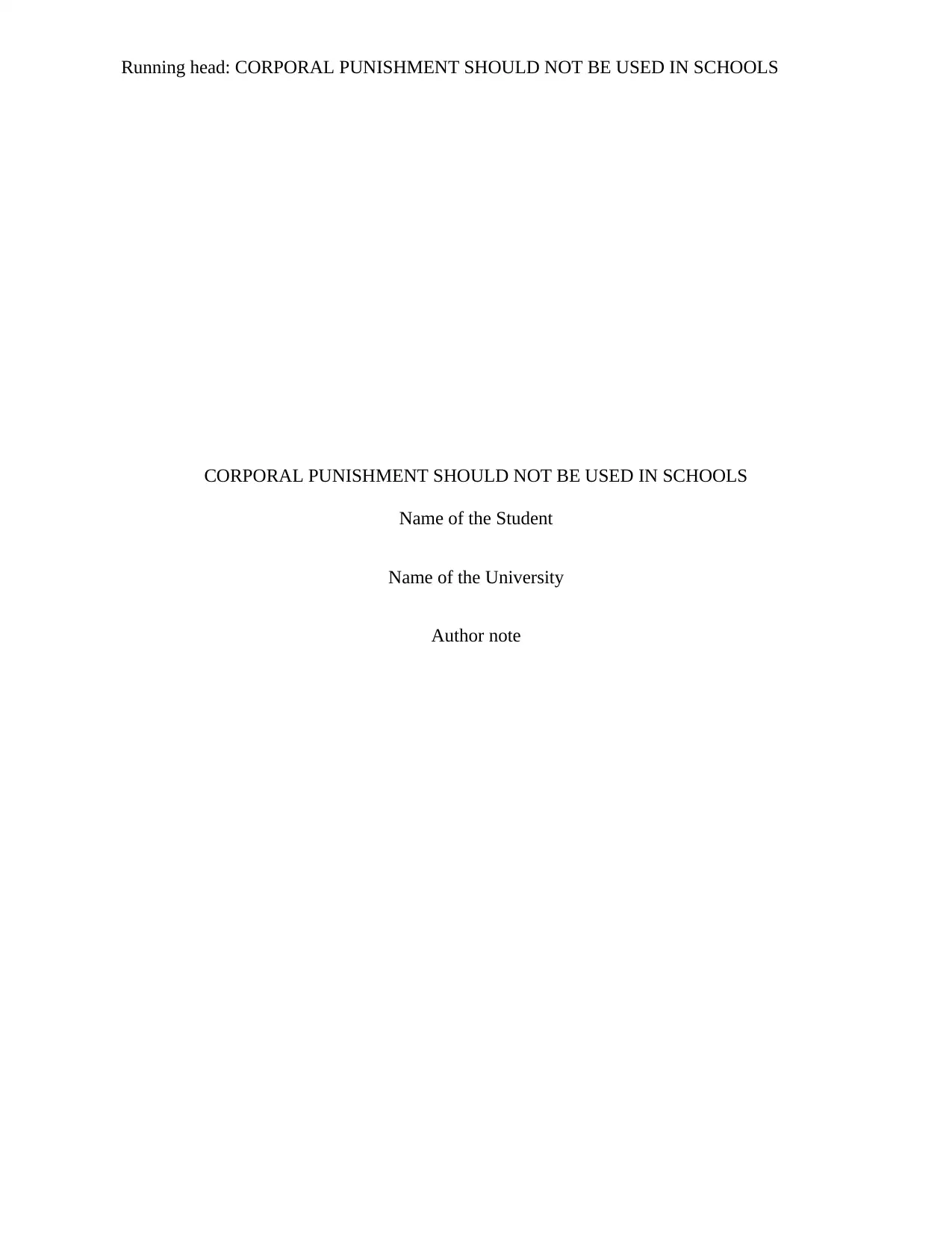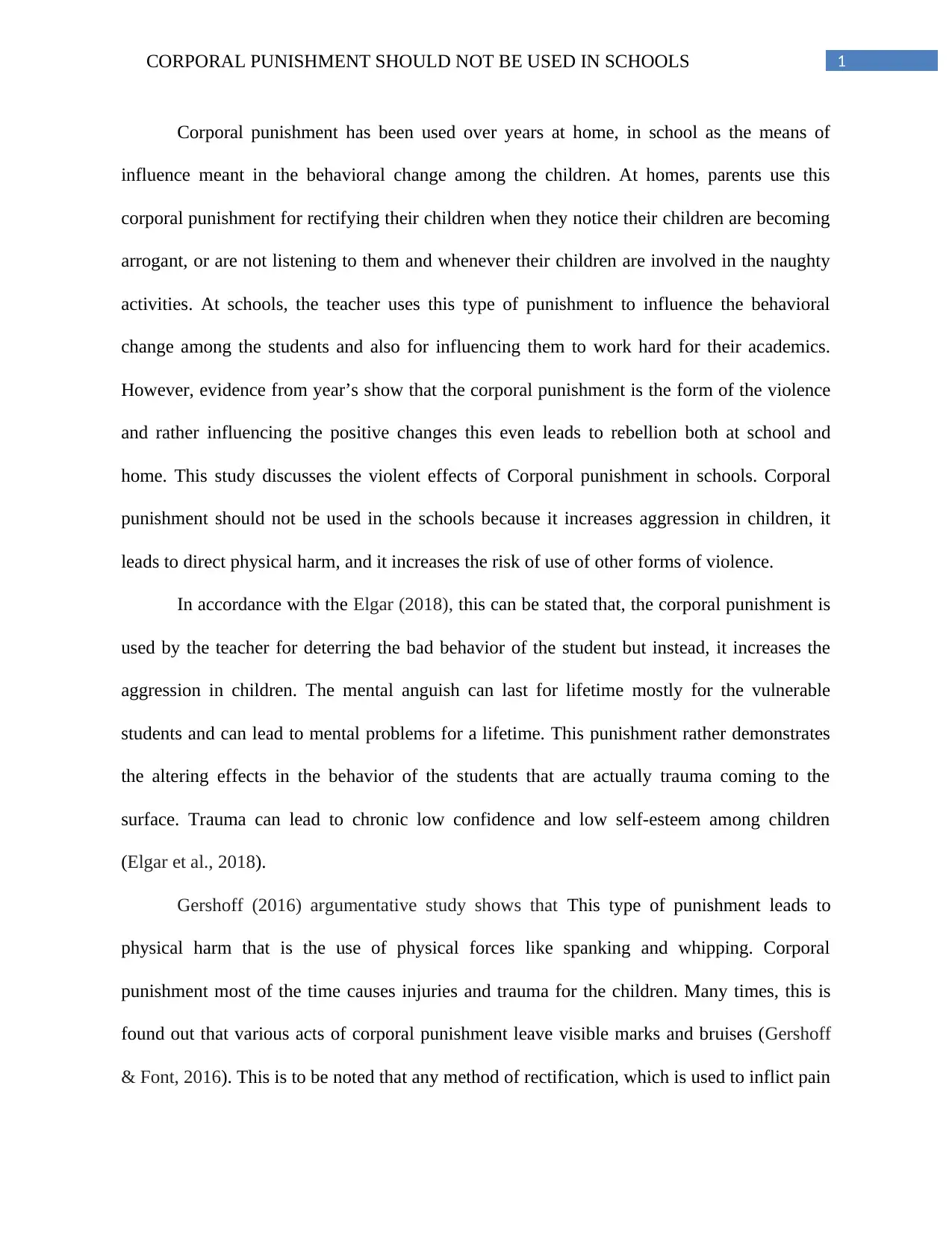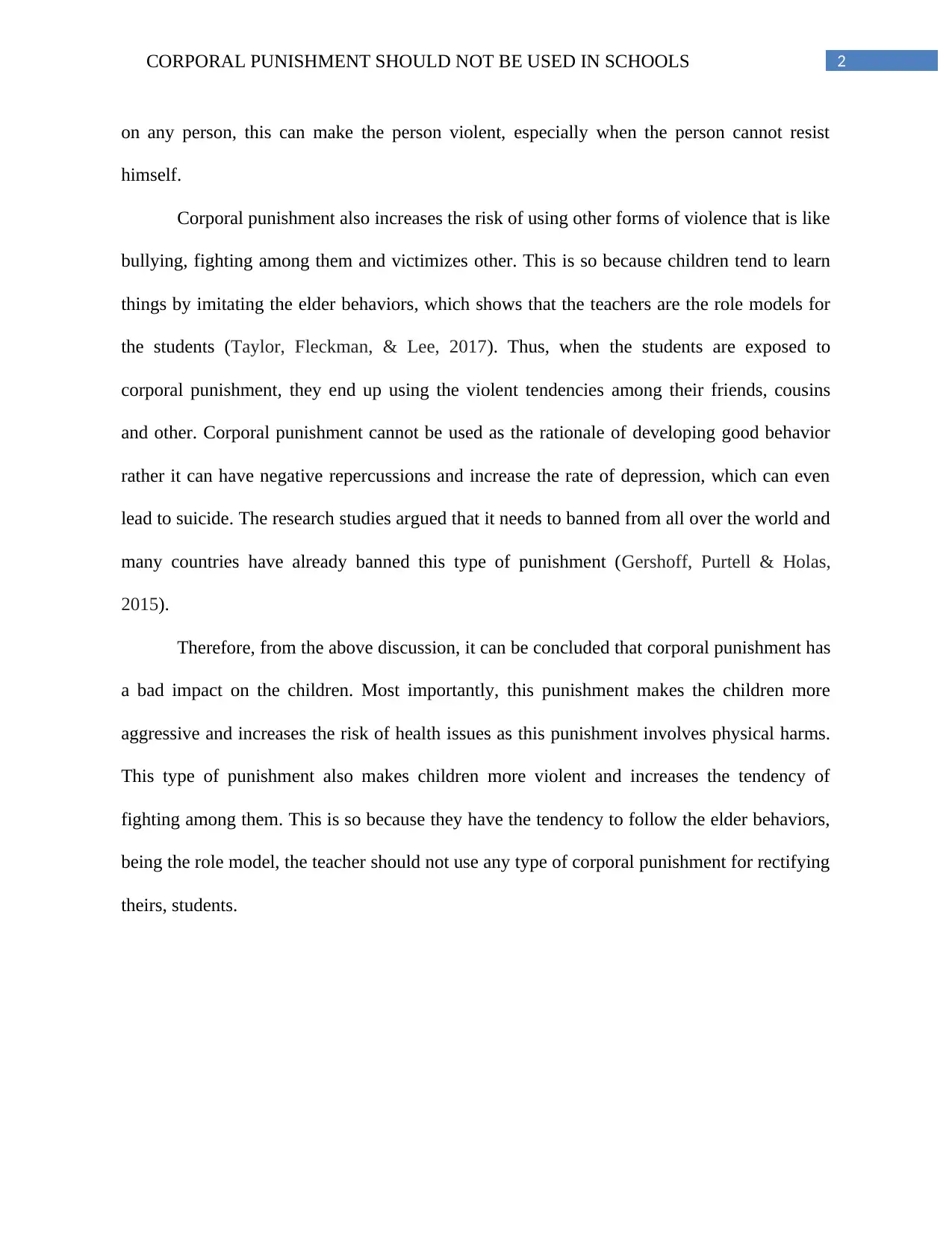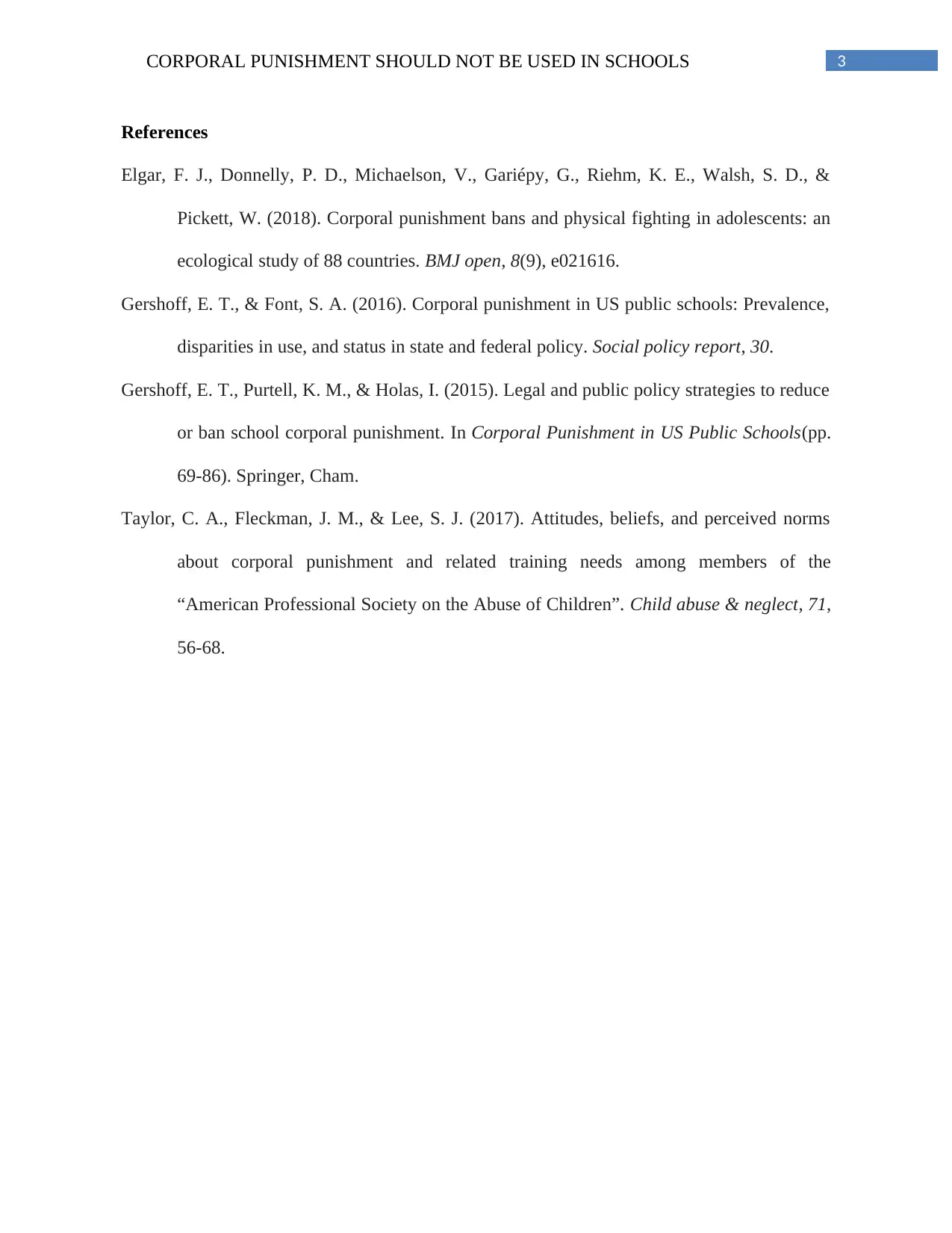Essay: The Negative Effects of Corporal Punishment in Schools
VerifiedAdded on 2021/12/08
|4
|891
|209
Essay
AI Summary
This essay argues against the use of corporal punishment in schools, presenting evidence-based arguments on its negative impacts. The author contends that corporal punishment increases aggression in children, leads to direct physical harm, and elevates the risk of other forms of violence, such as bullying. Drawing on research, the essay highlights the potential for lasting mental anguish, trauma, and reduced self-esteem among students subjected to this form of discipline. Furthermore, the essay emphasizes that children often imitate the behavior of adults, making teachers' actions critical role models. The conclusion reinforces the need to ban corporal punishment globally and encourages alternative disciplinary methods. The essay cites several research studies to support its claims.

Running head: CORPORAL PUNISHMENT SHOULD NOT BE USED IN SCHOOLS
CORPORAL PUNISHMENT SHOULD NOT BE USED IN SCHOOLS
Name of the Student
Name of the University
Author note
CORPORAL PUNISHMENT SHOULD NOT BE USED IN SCHOOLS
Name of the Student
Name of the University
Author note
Paraphrase This Document
Need a fresh take? Get an instant paraphrase of this document with our AI Paraphraser

1CORPORAL PUNISHMENT SHOULD NOT BE USED IN SCHOOLS
Corporal punishment has been used over years at home, in school as the means of
influence meant in the behavioral change among the children. At homes, parents use this
corporal punishment for rectifying their children when they notice their children are becoming
arrogant, or are not listening to them and whenever their children are involved in the naughty
activities. At schools, the teacher uses this type of punishment to influence the behavioral
change among the students and also for influencing them to work hard for their academics.
However, evidence from year’s show that the corporal punishment is the form of the violence
and rather influencing the positive changes this even leads to rebellion both at school and
home. This study discusses the violent effects of Corporal punishment in schools. Corporal
punishment should not be used in the schools because it increases aggression in children, it
leads to direct physical harm, and it increases the risk of use of other forms of violence.
In accordance with the Elgar (2018), this can be stated that, the corporal punishment is
used by the teacher for deterring the bad behavior of the student but instead, it increases the
aggression in children. The mental anguish can last for lifetime mostly for the vulnerable
students and can lead to mental problems for a lifetime. This punishment rather demonstrates
the altering effects in the behavior of the students that are actually trauma coming to the
surface. Trauma can lead to chronic low confidence and low self-esteem among children
(Elgar et al., 2018).
Gershoff (2016) argumentative study shows that This type of punishment leads to
physical harm that is the use of physical forces like spanking and whipping. Corporal
punishment most of the time causes injuries and trauma for the children. Many times, this is
found out that various acts of corporal punishment leave visible marks and bruises (Gershoff
& Font, 2016). This is to be noted that any method of rectification, which is used to inflict pain
Corporal punishment has been used over years at home, in school as the means of
influence meant in the behavioral change among the children. At homes, parents use this
corporal punishment for rectifying their children when they notice their children are becoming
arrogant, or are not listening to them and whenever their children are involved in the naughty
activities. At schools, the teacher uses this type of punishment to influence the behavioral
change among the students and also for influencing them to work hard for their academics.
However, evidence from year’s show that the corporal punishment is the form of the violence
and rather influencing the positive changes this even leads to rebellion both at school and
home. This study discusses the violent effects of Corporal punishment in schools. Corporal
punishment should not be used in the schools because it increases aggression in children, it
leads to direct physical harm, and it increases the risk of use of other forms of violence.
In accordance with the Elgar (2018), this can be stated that, the corporal punishment is
used by the teacher for deterring the bad behavior of the student but instead, it increases the
aggression in children. The mental anguish can last for lifetime mostly for the vulnerable
students and can lead to mental problems for a lifetime. This punishment rather demonstrates
the altering effects in the behavior of the students that are actually trauma coming to the
surface. Trauma can lead to chronic low confidence and low self-esteem among children
(Elgar et al., 2018).
Gershoff (2016) argumentative study shows that This type of punishment leads to
physical harm that is the use of physical forces like spanking and whipping. Corporal
punishment most of the time causes injuries and trauma for the children. Many times, this is
found out that various acts of corporal punishment leave visible marks and bruises (Gershoff
& Font, 2016). This is to be noted that any method of rectification, which is used to inflict pain

2CORPORAL PUNISHMENT SHOULD NOT BE USED IN SCHOOLS
on any person, this can make the person violent, especially when the person cannot resist
himself.
Corporal punishment also increases the risk of using other forms of violence that is like
bullying, fighting among them and victimizes other. This is so because children tend to learn
things by imitating the elder behaviors, which shows that the teachers are the role models for
the students (Taylor, Fleckman, & Lee, 2017). Thus, when the students are exposed to
corporal punishment, they end up using the violent tendencies among their friends, cousins
and other. Corporal punishment cannot be used as the rationale of developing good behavior
rather it can have negative repercussions and increase the rate of depression, which can even
lead to suicide. The research studies argued that it needs to banned from all over the world and
many countries have already banned this type of punishment (Gershoff, Purtell & Holas,
2015).
Therefore, from the above discussion, it can be concluded that corporal punishment has
a bad impact on the children. Most importantly, this punishment makes the children more
aggressive and increases the risk of health issues as this punishment involves physical harms.
This type of punishment also makes children more violent and increases the tendency of
fighting among them. This is so because they have the tendency to follow the elder behaviors,
being the role model, the teacher should not use any type of corporal punishment for rectifying
theirs, students.
on any person, this can make the person violent, especially when the person cannot resist
himself.
Corporal punishment also increases the risk of using other forms of violence that is like
bullying, fighting among them and victimizes other. This is so because children tend to learn
things by imitating the elder behaviors, which shows that the teachers are the role models for
the students (Taylor, Fleckman, & Lee, 2017). Thus, when the students are exposed to
corporal punishment, they end up using the violent tendencies among their friends, cousins
and other. Corporal punishment cannot be used as the rationale of developing good behavior
rather it can have negative repercussions and increase the rate of depression, which can even
lead to suicide. The research studies argued that it needs to banned from all over the world and
many countries have already banned this type of punishment (Gershoff, Purtell & Holas,
2015).
Therefore, from the above discussion, it can be concluded that corporal punishment has
a bad impact on the children. Most importantly, this punishment makes the children more
aggressive and increases the risk of health issues as this punishment involves physical harms.
This type of punishment also makes children more violent and increases the tendency of
fighting among them. This is so because they have the tendency to follow the elder behaviors,
being the role model, the teacher should not use any type of corporal punishment for rectifying
theirs, students.
⊘ This is a preview!⊘
Do you want full access?
Subscribe today to unlock all pages.

Trusted by 1+ million students worldwide

3CORPORAL PUNISHMENT SHOULD NOT BE USED IN SCHOOLS
References
Elgar, F. J., Donnelly, P. D., Michaelson, V., Gariépy, G., Riehm, K. E., Walsh, S. D., &
Pickett, W. (2018). Corporal punishment bans and physical fighting in adolescents: an
ecological study of 88 countries. BMJ open, 8(9), e021616.
Gershoff, E. T., & Font, S. A. (2016). Corporal punishment in US public schools: Prevalence,
disparities in use, and status in state and federal policy. Social policy report, 30.
Gershoff, E. T., Purtell, K. M., & Holas, I. (2015). Legal and public policy strategies to reduce
or ban school corporal punishment. In Corporal Punishment in US Public Schools(pp.
69-86). Springer, Cham.
Taylor, C. A., Fleckman, J. M., & Lee, S. J. (2017). Attitudes, beliefs, and perceived norms
about corporal punishment and related training needs among members of the
“American Professional Society on the Abuse of Children”. Child abuse & neglect, 71,
56-68.
References
Elgar, F. J., Donnelly, P. D., Michaelson, V., Gariépy, G., Riehm, K. E., Walsh, S. D., &
Pickett, W. (2018). Corporal punishment bans and physical fighting in adolescents: an
ecological study of 88 countries. BMJ open, 8(9), e021616.
Gershoff, E. T., & Font, S. A. (2016). Corporal punishment in US public schools: Prevalence,
disparities in use, and status in state and federal policy. Social policy report, 30.
Gershoff, E. T., Purtell, K. M., & Holas, I. (2015). Legal and public policy strategies to reduce
or ban school corporal punishment. In Corporal Punishment in US Public Schools(pp.
69-86). Springer, Cham.
Taylor, C. A., Fleckman, J. M., & Lee, S. J. (2017). Attitudes, beliefs, and perceived norms
about corporal punishment and related training needs among members of the
“American Professional Society on the Abuse of Children”. Child abuse & neglect, 71,
56-68.
1 out of 4
Related Documents
Your All-in-One AI-Powered Toolkit for Academic Success.
+13062052269
info@desklib.com
Available 24*7 on WhatsApp / Email
![[object Object]](/_next/static/media/star-bottom.7253800d.svg)
Unlock your academic potential
Copyright © 2020–2025 A2Z Services. All Rights Reserved. Developed and managed by ZUCOL.





